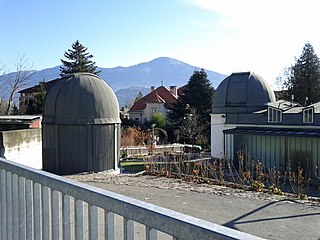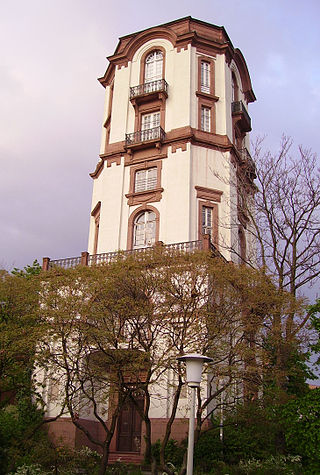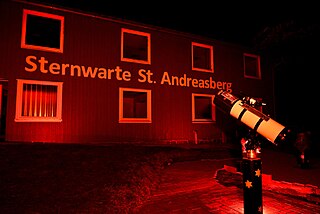
Photographic plates preceded photographic film as a capture medium in photography. The light-sensitive emulsion of silver salts was coated on a glass plate, typically thinner than common window glass. They were heavily used in the late 19th century and declined through the 20th. They were still used in some communities until the late 20th century.
Eva Ahnert-Rohlfs was a German astronomer. She made key observations of variable stars.

The Starkenburg Observatory is an astronomical observatory in Heppenheim, Germany. It was founded in 1970, and currently has about 150 members.

The Berlin Observatory is a German astronomical institution with a series of observatories and related organizations in and around the city of Berlin in Germany, starting from the 18th century. It has its origins in 1700 when Gottfried Leibniz initiated the "Brandenburg Society of Science″ which would later (1744) become the Prussian Academy of Sciences. The Society had no observatory but nevertheless an astronomer, Gottfried Kirch, who observed from a private observatory in Berlin. A first small observatory was furnished in 1711, financing itself by calendrical computations.

Hoher ListObservatorium is an Observatory located on the Hoher List mountain about 60 km south-west of the city of Bonn, close to the town of Daun in the Eifel region (Rhineland-Palatinate)

Stuttgart Observatory is an astronomical observatory owned and operated by the association Schwäbische Sternwarte e.V. It is located on the Uhlandshöhe in Stuttgart, Germany. Public tours have been held since 1920 and the observatory claims to be one of the oldest in Germany.

Hamburg Observatory is an astronomical observatory located in the Bergedorf borough of the city of Hamburg in northern Germany. It is owned and operated by the University of Hamburg, Germany since 1968, although it was founded in 1825 by the City of Hamburg and moved to its present location in 1912. It has operated telescopes at Bergedorf, at two previous locations in Hamburg, at other observatories around the world, and it has also supported space missions.

Astrophysikalisches Institut und Universitäts-Sternwarte Jena is an astronomical observatory owned and operated by Friedrich Schiller University of Jena. It has two main locations in Jena, Germany

Innsbruck Observatory is an astronomical observatory owned and operated by the institutes of astrophysics out of the University of Innsbruck. It is located in Innsbruck, Austria.

The Sternwarte Düsseldorf in Düsseldorf-Bilk was a private observatory founded in 1843 by Johann Friedrich Benzenberg. The observatory's main feature was a refracting telescope with 1800mm focal length. After Benzenberg's death the observatory was bequeathed to the city of Düsseldorf. It was destroyed by bombing in 1943.

The Archenhold Observatory was named in honour of Friedrich Simon Archenhold, is an observatory in Berlin-Treptow. It houses the Großer Refraktor, which is the longest pointable telescope in the world. It is also called Die Himmelskanone.

Leibniz Institute for Astrophysics Potsdam (AIP) is a German research institute. It is the successor of the Berlin Observatory founded in 1700 and of the Astrophysical Observatory Potsdam (AOP) founded in 1874. The latter was the world's first observatory to emphasize explicitly the research area of astrophysics. The AIP was founded in 1992, in a re-structuring following the German reunification.

The Mannheim Observatory was a tower observatory built between 1772 and 1774 in Mannheim, Germany, which remained in operation until 1880. The observatory was transferred to Karlsruhe and finally in 1898, was established on the Königstuhl near Heidelberg where today's successor institution the State Observatory Heidelberg-Königstuhl is located.

Urania Sternwarte is a public observatory in the Lindenhof quarter of Zürich, Switzerland. Its name Urania refers to the muse of astronomy in Greek mythology.

Gotha Observatory was a German astronomical observatory located on Seeberg hill near Gotha, Thuringia, Germany. Initially the observatory was dedicated to astrometry, geodetic and meteorological observation and tracking the time.

Sternwarte Peterberg is a club observatory in Saarland, Germany. Founded in 1977, it has 160 members as of 2016.

The Sankt Andreasberg Observatory, also called Harz Observatory, is a project of the charitable society Sternwarte Sankt Andreasberg e. V., which translates into Sankt Andreasberg Observatory registered society. It was opened in August 2014 and is supposed to become the first completely barrier free Observatory in Germany. The society's expressive goal is to make the sky accessible to all people, whether they are disabled or not. Celestial observation, lectures and Workshops convey general astronomical knowledge to visitors.

The Public Observatory Regensburg is an astronomical observatory located in Regensburg, Germany. Its history dates back to the year 1774 when Saint Emmeram's Abbey dedicated two towers to astronomical observations. For the most time, it served for educational purposes. Today it is run by a non-profit organization, the Verein der Freunde der Sternwarte Regensburg e.V.. The observatory is accessible for visitors on Friday evenings.

Zweibrücken Observatory, or the Zweibrück Observatory of the Natural Science Association, is a public observatory in Zweibrücken, Germany. Its dome was painted to resemble the Star Wars character R2-D2 in 2018.

QZ Aurigae, also known as Nova Aurigae 1964, was a nova which occurred in the constellation Auriga during 1964. It was discovered by Nicholas Sanduleak on an objective prism photographic plate taken at the Warner and Swasey Observatory on 4 November 1964. Examination of pre-discovery plates from Sonneberg Observatory showed that the eruption occurred in early February 1964, and it had a photographic magnitude of 6.0 on 14 February 1964. Its brightness declined in images taken after the 14th, suggesting that its peak brightness was above 6.0. It was probably visible to the naked eye for a short time.





















